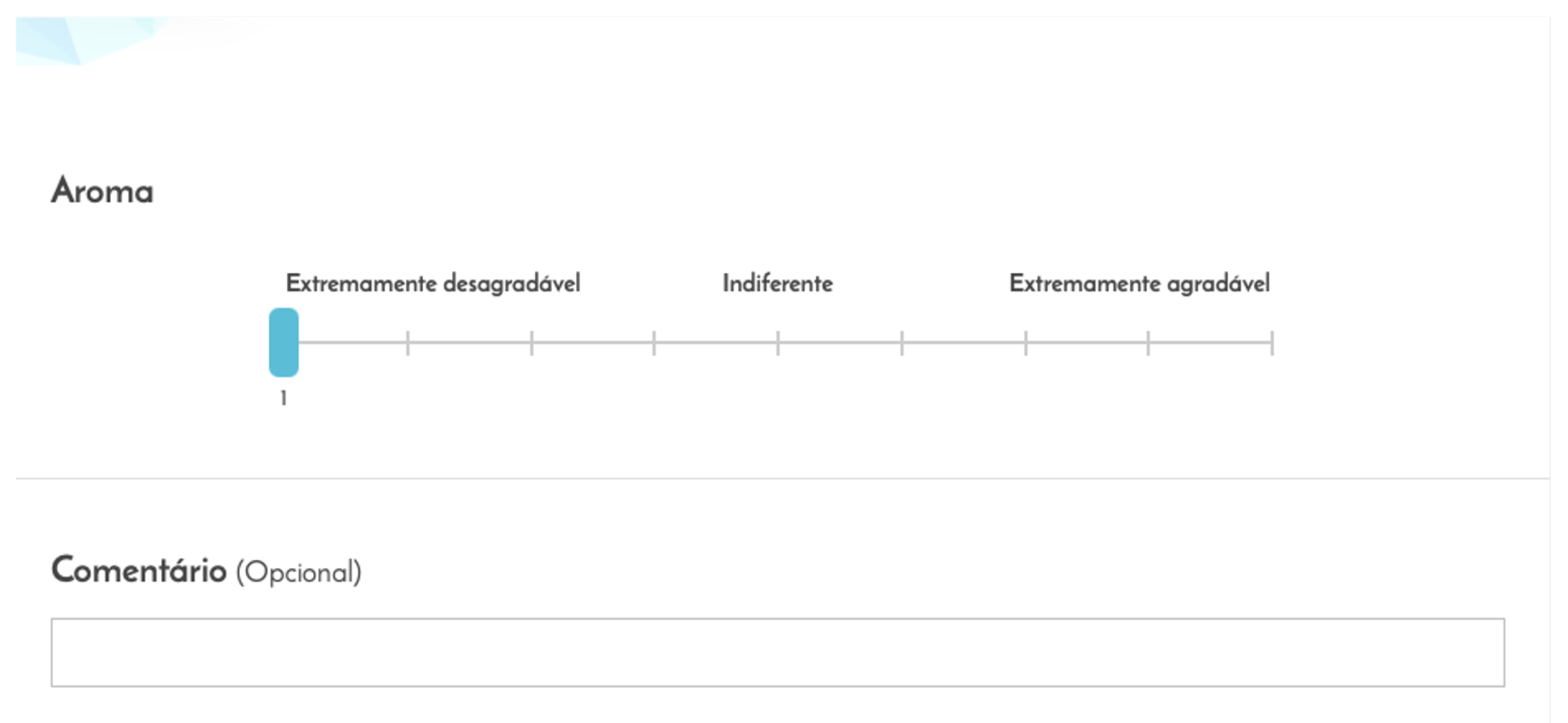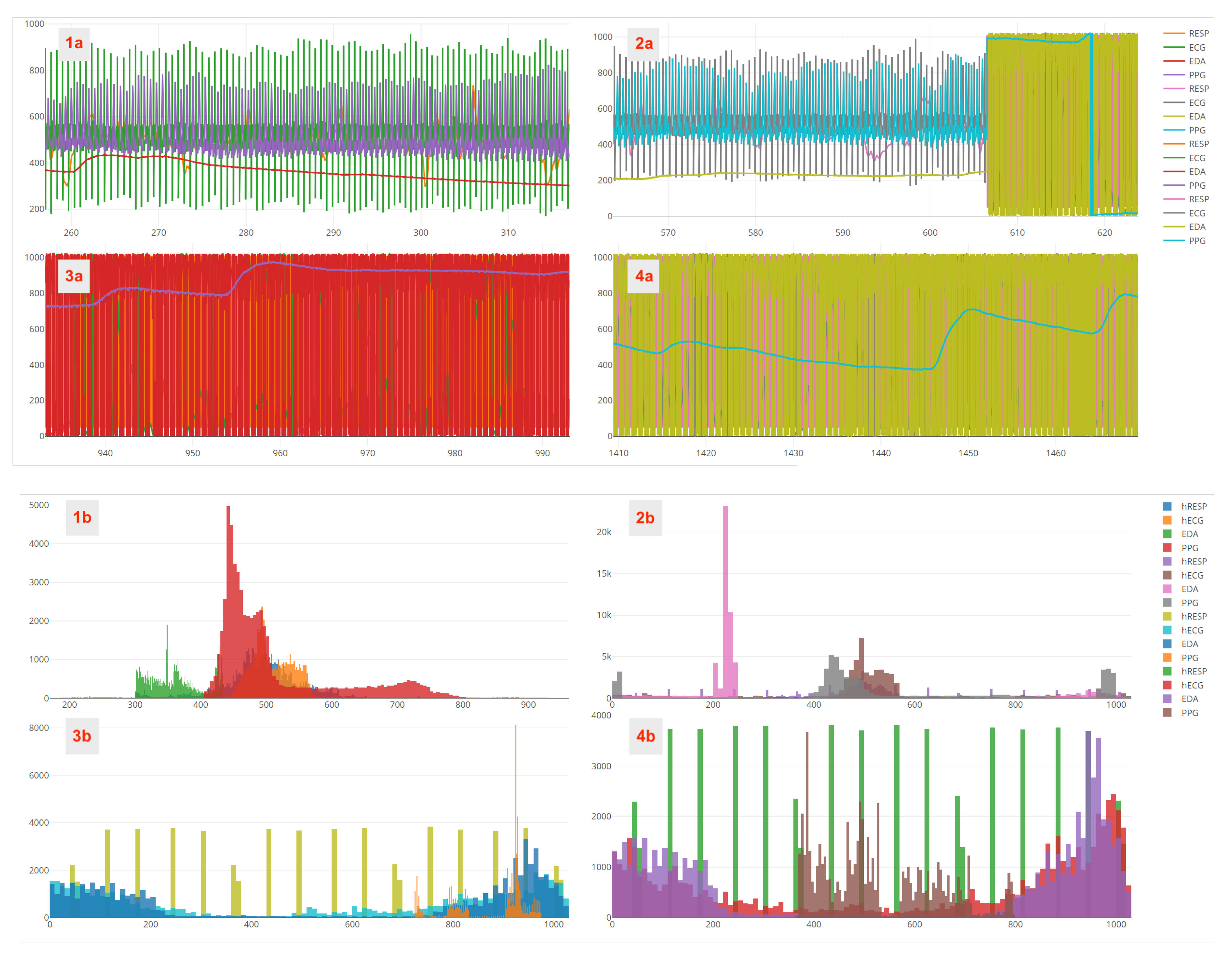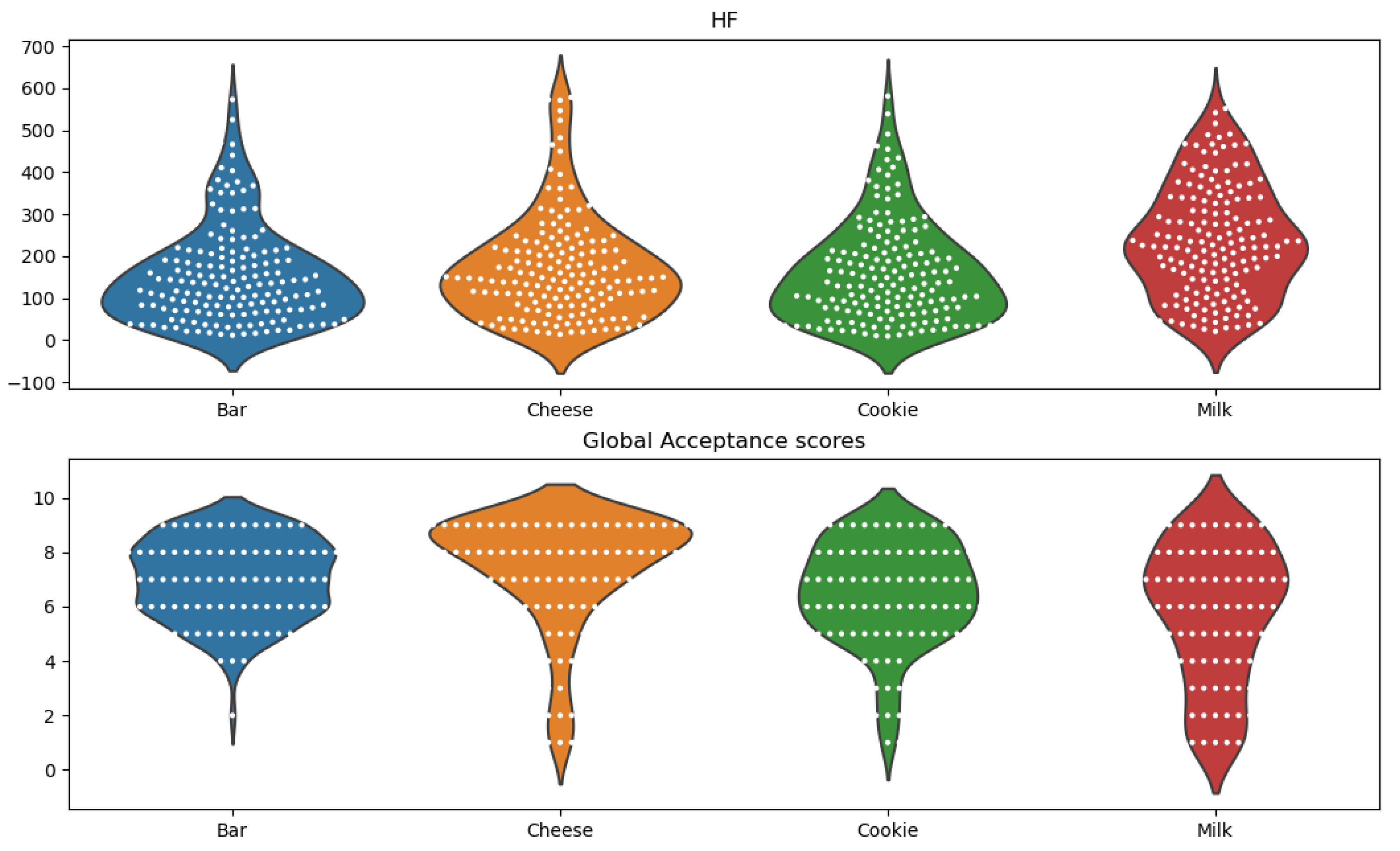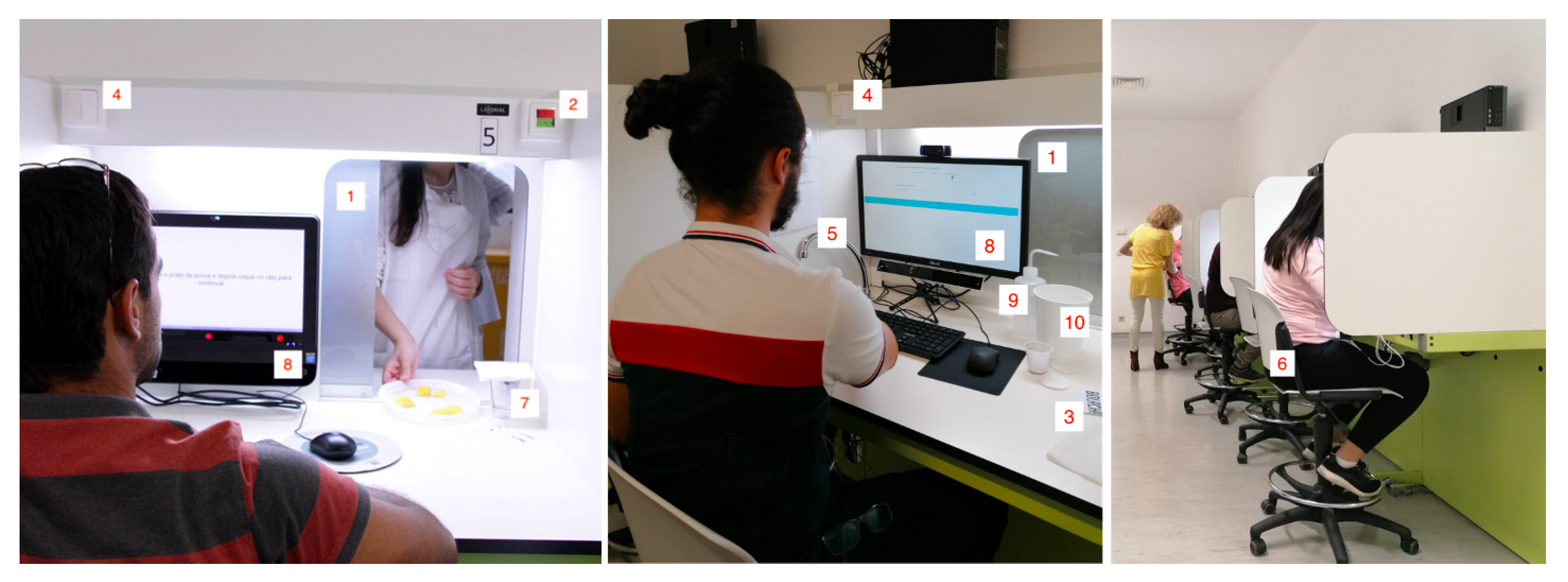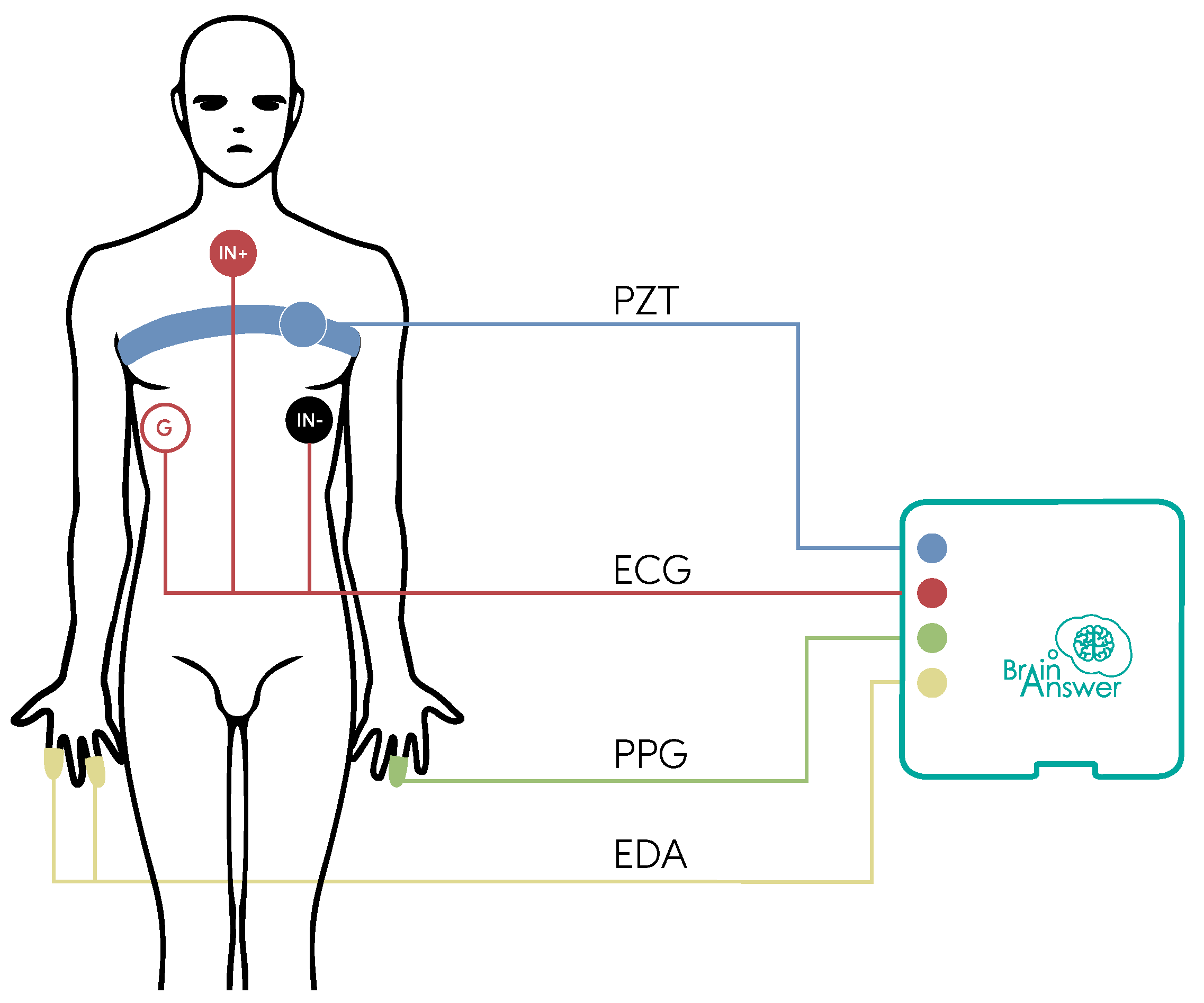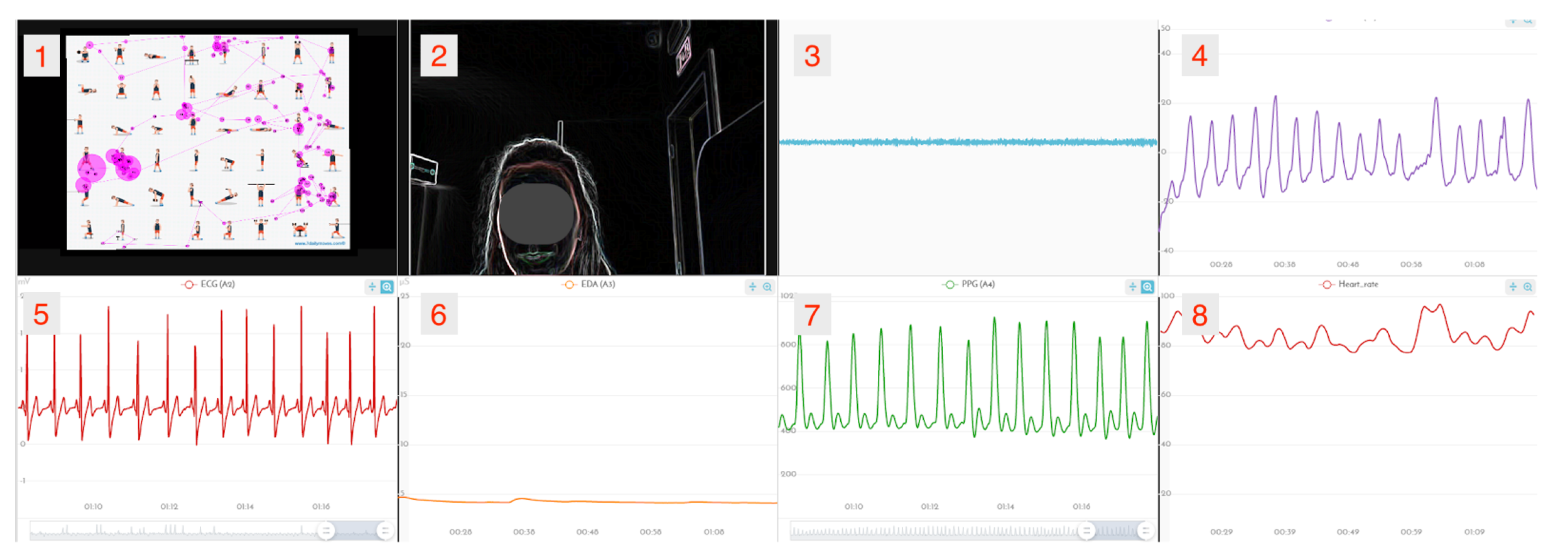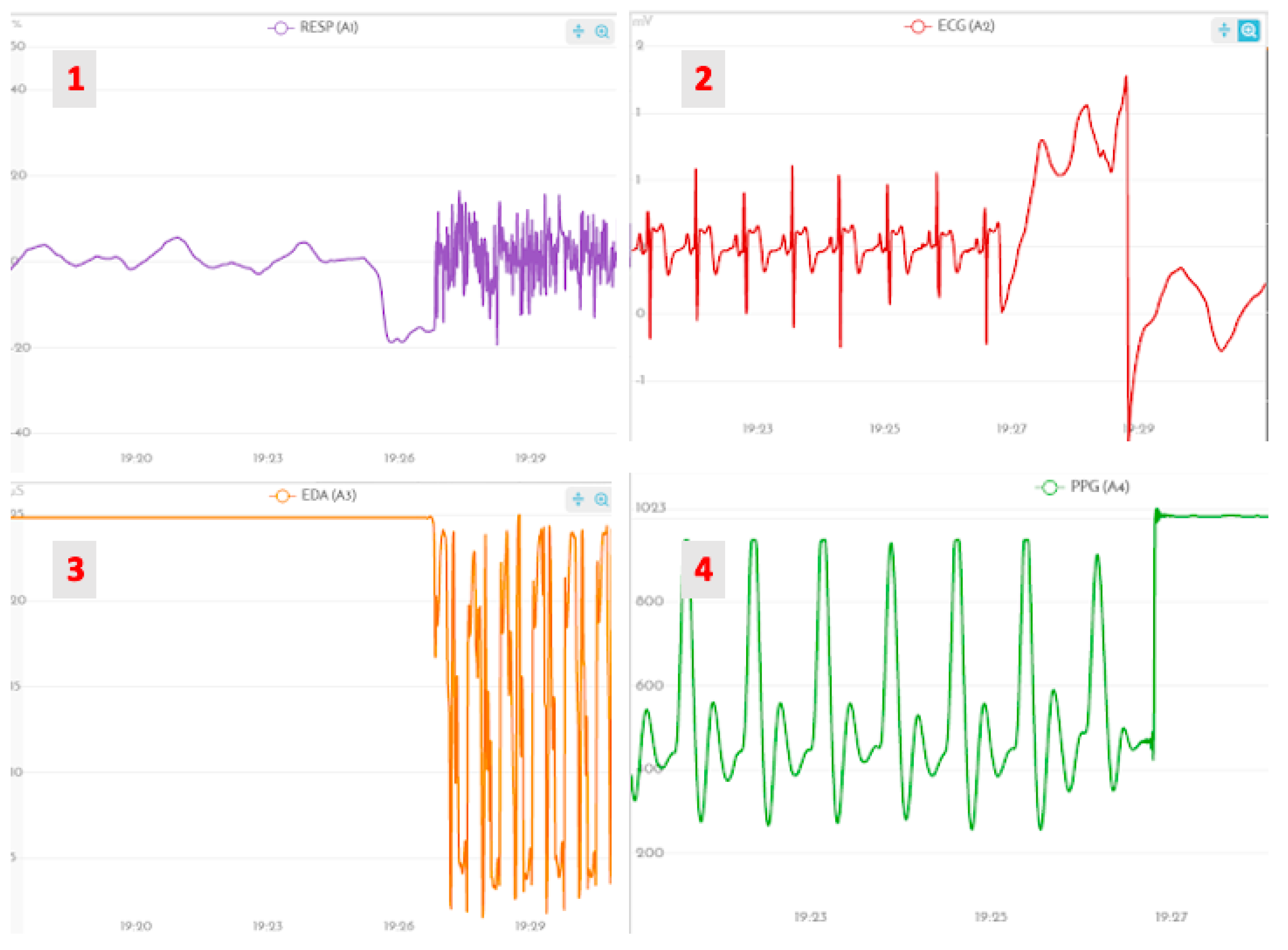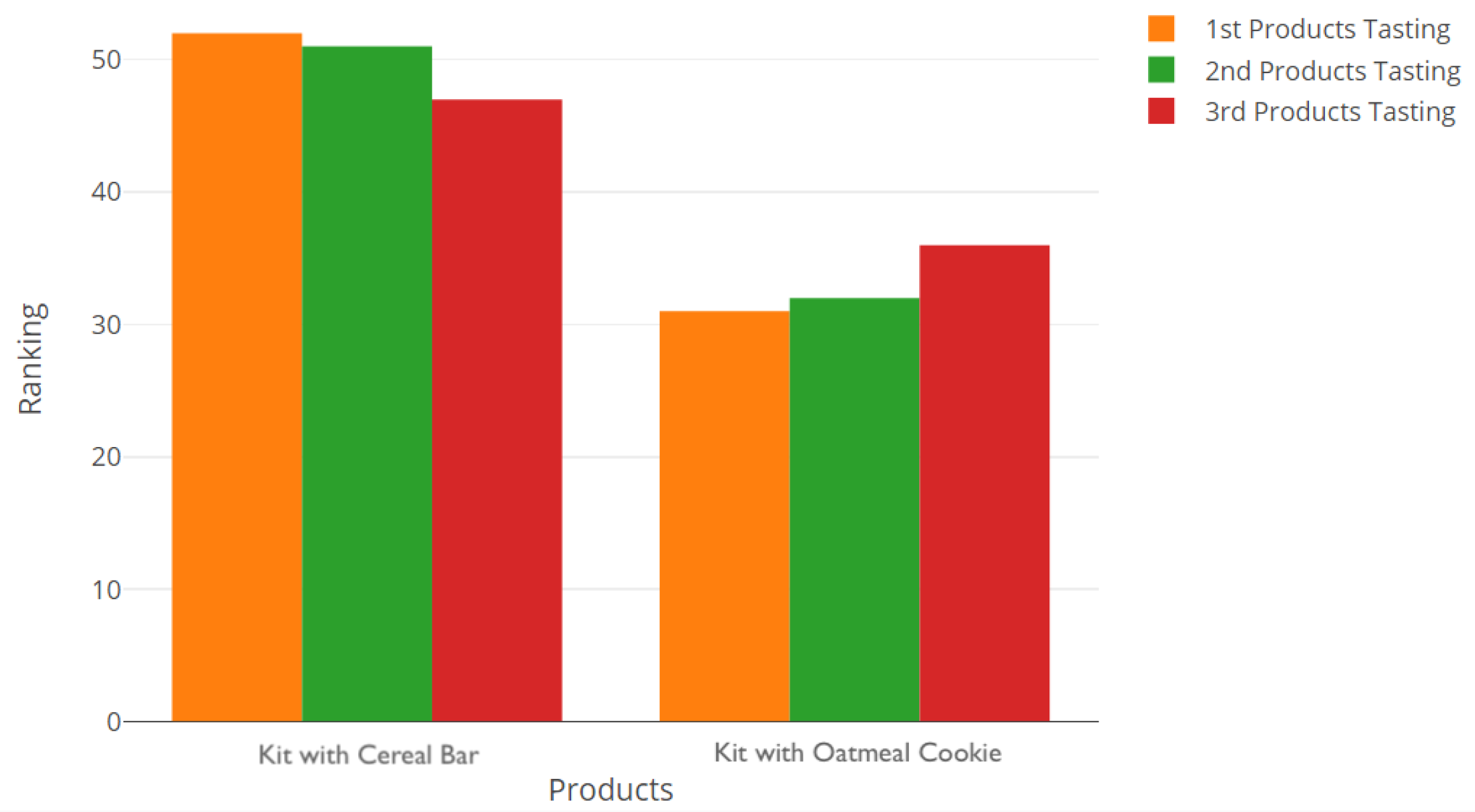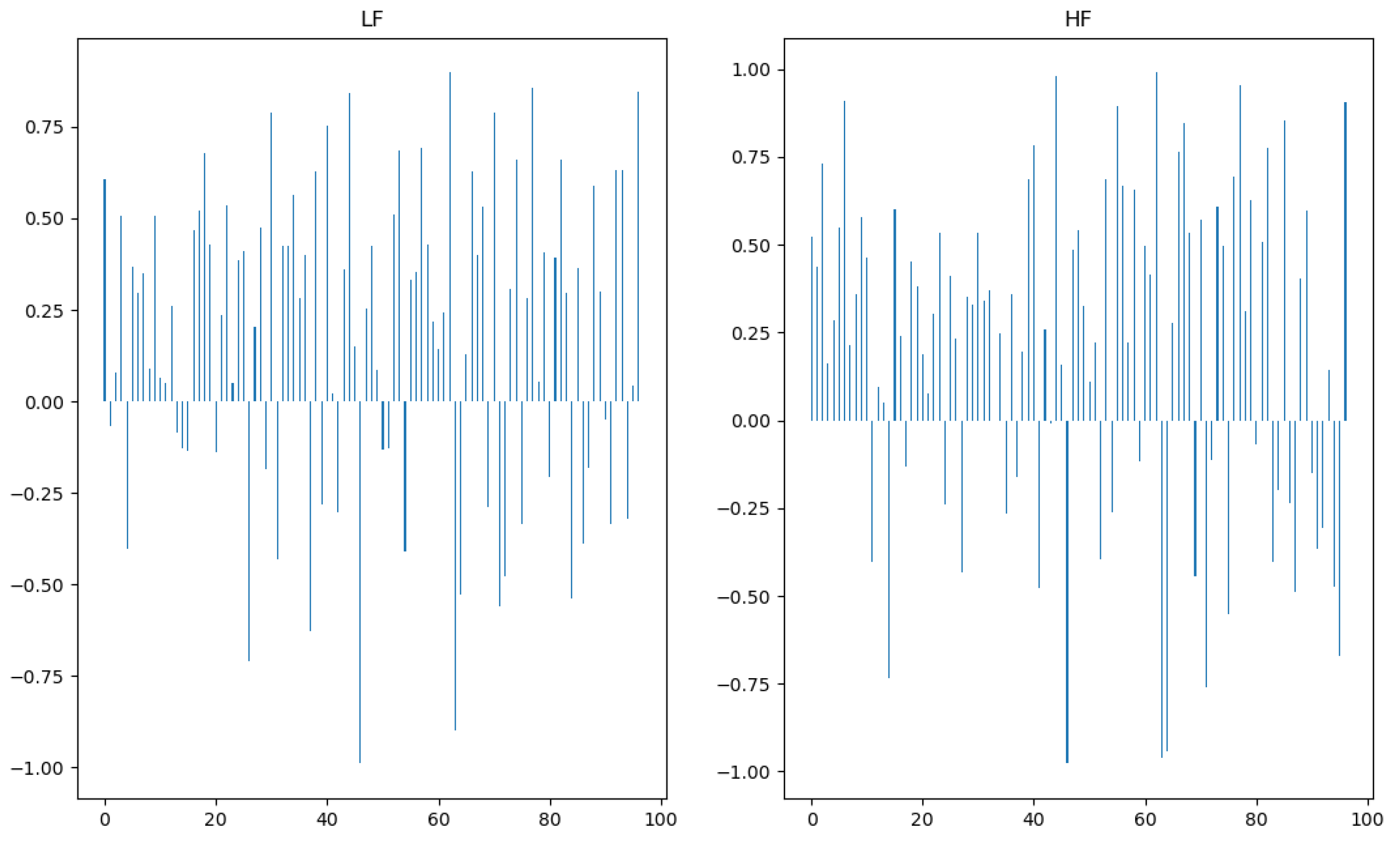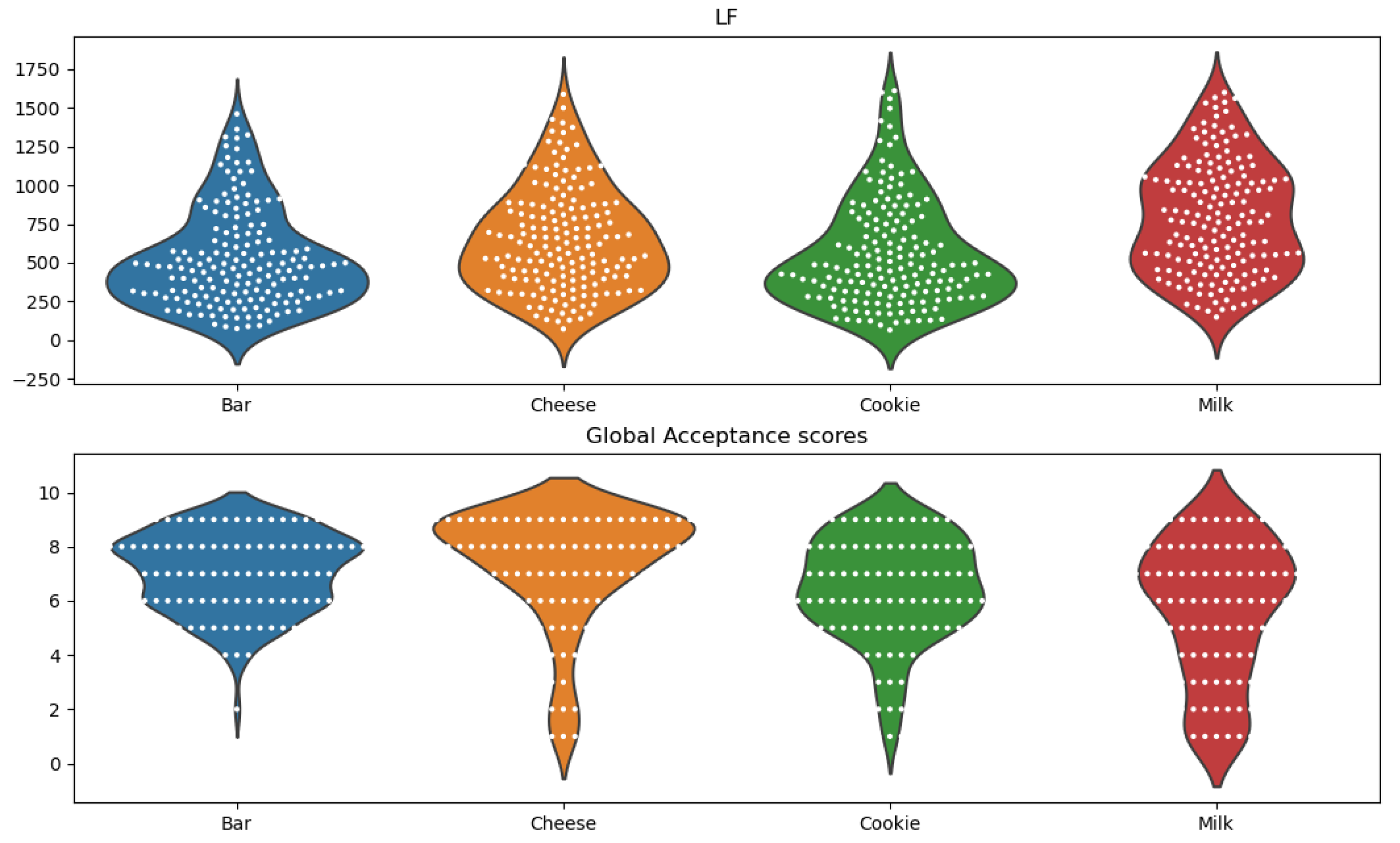1. Introduction
In recent years, increasing attention has been given to the challenge of understanding the reasons behind consumers’ choices and selections, particularly in the food and beverage industry [
1]. One of the big questions researchers are trying to answer nowadays is whether psychophysiological responses can provide new insights into the decision-making process of consumers. Specifically concerning edible products, there is a great interest in obtaining accurate and objective data about the sensory perception of food and beverages and, consequently, about consumption intention [
2,
3,
4]. This field of study can be greatly reinforced through the development of new and more in-depth protocols of sensory analysis, capable of complementing self-reporting questionnaires with the use of psychophysiological traits.
When it comes to tasting food, the authors of [
5] defined three main emotional processing levels: The low processing level, when subjects integrate information from the five senses through psychophysiological, unconscious, processes; the intermediate processing level, when subjects connect their perceptions to past experiences and information already present in their memory, through both conscious and unconscious processes; and lastly, the high processing level, when subjects consciously recognise what the samples they are tasting are able to express which emotions they evoke (e.g., if the taste matched their expectations, if the visual appearance of the product is pleasant, among many others) [
6].
In addition to organoleptic assessment, the traditional sensory testing methods rely on self-report questionnaires, as they present unquestionable advantages, such as being easy to deploy and being cost-effective [
7,
8]. However, this approach also presents some limitations. The main one is that, by only being able to target the high processing level and obtaining conscious responses, they are not depicting the low and intermediate processing levels, potentially leaving out relevant unconscious processes present in these [
9]. Moreover, self-report questionnaires, by targeting the high processing level, are also subjected to the inherent difficulty of subjects having to reconstruct and interpret their thoughts and motivations, and/or to verbally express and assess them [
10,
11]. This, combined with the fact that the expression and assessment of emotions (e.g., liking, pleasure, etc.) varies across cultures and languages [
5,
11], can make the results of self-assessment questionnaires only representative by enrolling a sufficiently high number of subjects. Finally, the last constraint of self-assessment questionnaires is that they only obtain declared opinions, not revealing responses that the consumers may not wish to disclose (e.g., because they are socially undesirable) [
10,
11,
12].
The use of psychophysiological data has the potential to overcome these limitations, with the advantage of being able to depict the low and intermediate processing levels, and not depending on the verbal declared expression of subjects to obtain measurable results [
9,
13]. The physiological data and derived features used in this area can be divided into two main groups, one related to recording the activity of the brain, by electroencephalography (EEG), and another using peripheral measurements. The latter is generally easier to deploy, and includes signals such as ElectroDermal Activity (EDA), Heart Rate (HR), Skin Temperature (ST), Blood Pressure (BP), pupillometry, eye-tracking (ET), and facial expressions [
5,
9,
12]. These signals are common in studies related to neuropsychology and affective state assessment, since they provide valuable insights into the Autonomic Nervous System (ANS) [
14].
The ANS integrates the Sympathetic Nervous System (SNS), which conducts the body’s responses in case of a threat, and the Parasympathetic Nervous System (PNS), which is in charge of homeostasis [
9,
15]. Both the SNS and PNS control the cardiac dynamics (e.g., HR), the dilation and constriction of blood vessels’ diameters (BP), pupils (pupillometry and ET), bronchial tubes (respiration), and the contraction and relaxation of muscles, modulating these responses according to the environment and stimuli [
16]. The EDA response is, on the other hand, only influenced by the SNS, being more associated with stressful or arousing events [
17]. As a consequence of many of these responses (e.g., muscle constriction/relaxation, sweating and vasoconstriction/vasodilatation), the body temperature varies, which makes it an indirect measure of ANS responses [
16]. All in all, the ANS is responsible for the unconscious responses of the human body, which are associated with an emotional response, arousal, and stress [
14].
That being said, using psychophysiological sensing in food and beverage sensory testing is a natural complement to traditional consumer research methods. This approach can be designated as neuroorganoleptics, and it allows reaching every processing level involved in the tasting of food and beverages, enabling researchers and other stakeholders to more accurately obtain information about the consumer’s food perceptions and preferences. It has only recently started to be investigated in the state-of-the-art, as shown by a group of researchers from the University of Melbourne, who applied this novel sensory analysis approach to assess consumers’ acceptability of different samples of beer [
18] and chocolate [
19].
With this in mind, this paper describes a comprehensive protocol for neuroorganoleptic testing. It has been applied to a case study project (MobFood), further described in
Section 3. The case study had the goal of analysing the acceptability and consumption intention of four different food samples that were part of a breakfast kit, combining the typical self-reporting questionnaires with psychophysiological data analysis. The signals included in this protocol were EDA, Photoplethysmography (PPG), Respiration (PZT), Electrocardiography (ECG), and Eye-Tracking (ET). A webcam and microphone were also used to record the environmental context of the experiment.
The remainder of the work is organised as follows:
Section 2 describes the design considerations of the proposed neuroorganoleptic testing protocol;
Section 3 details the application of the devised protocol to the MobFood case study;
Section 4 summarises the main findings and results from this case study; and, finally,
Section 5 provides a brief discussion and future work guidelines.
3. MobFood Case Study
3.1. Overview
For testing purposes, our protocol was applied to a case study project named MobFood (
https://mobfood.pt/en/, accessed on 23 August 2021). The focus of this study was to create a breakfast kit composed of three food and beverage products, chosen according to the perceived preferences of a panel of assessors tasting four samples, namely: a cereal bar, cheese, chocolate milk, and an oatmeal cookie. The case study was conducted in the certified sensory analysis laboratory of CATAA (Centro de Apoio Tecnológico Agro-Alimentar) in Castelo Branco, which follows the requirements mentioned in
Section 2.2.
3.2. Population
The participants in this experiment were recruited by an external company. This was a professional recruitment firm that handled the participant selection, the institutional review board approval, and informed consent. Exclusion conditions from the study included the intake of certain medications (e.g., muscle relaxants and sedatives), as well as specific clinical conditions, such as vision impairment and neurological, cardiac, and dermatological diseases. The results analysed were collected from 83 participants (40 male and 43 female), with ages between 23 and 38 years old (average of 28.80 ± 4.36 years). The participants received monetary compensation for their participation in the study.
There were two training sessions before the actual experiment. These sessions allowed the participants to become familiarised with the protocol, minimising the novelty effect. A shorter protocol was followed in these sessions, involving only two food and beverage samples, one solid (a cookie), and one liquid (a glass of water).
The main experiment was composed of three sessions on different days. Every participant considered in the results participated in the three sessions. The three sessions followed the same protocol and the same type of food samples were used. This approach allows testing repeatability between sessions, in terms of self-reported data and even physiological data.
3.3. Methodology
The experiment was performed according to predefined scheduling, for which each participant had a total time slot of 1 h and 30 min allocated (
Table 4). In each session, as the participants arrived at their individual booth, they placed the sensors themselves (using an instructional video as guidance), calibrated the eye-tracking software, opened the
BrainAnswer platform, and started our proposed protocol (
Section 2). The completion time of the protocol was between 15 and 62 min, with an average of 29.1 ± 9.0 min. A total of 290 data collection sessions were performed over the course of 3 months.
The main stages to the neuroorganoleptic protocol were: (a) relaxing; (b) preference-ordering tasks with visual stimulus; (c) acceptance assessment questions regarding the samples of each product using the hedonic scales; (d) preference and acceptance questions about the breakfast kit (three of the four products tasted together); and, finally, (e) general questions about food neophobia and socio-demographic characteristics.
The first step involved participants looking at an image meant to relax the volunteers, containing several small figures working out, selected due to the food and beverage neutral content. This first step was important to establish a baseline for the physiological signals and test the eye-tracking calibration.
After this, the protocol proceeded to the preference-ordering tasks with visual stimulus. The main focus of physiological data acquisition in this task was eye-tracking. The visual stimuli in this step were presented to the participants in random order on the screen, and they stayed on the screen for 10 s. Before presenting each set of stimuli images, the participants were requested to stare at a calibration cross in the middle of the screen. The first task of this step was to order the four elements of the kit by preference. The second task was to order a set, including one of the products of the kit and two similar products from competitors, by preference. For instance, the cereal bar of the kit was presented alongside a chocolate cereal bar and an apple cereal bar. This task was repeated four times (one for each product of the kit), and the order of this repetition was random.
Following this came the acceptance assessment questions regarding the samples of each product, using hedonic scales. A product of the kit appeared on the screen, and the assessor then used the switch of the light signal system (connecting the booth to the preparation area), to indicate that he/she was ready to receive the product. The sliding door opened, the assessor used non-verbal communication by giving the paper card with the product, and received the sample from the preparation area. The participant was then asked to assess the visual look of the sample before tasting it, to taste it for 60 s and, following that, to assess the various organoleptic characteristics present in
Table 5 using the scales indicated in
Section 2 (illustrated in
Figure A1). This task was repeated four times, one for each product of the kit, and the order of this repetition was random.
After this came the stage related to the breakfast kit composed of three of the four products studied. In this stage, only visual stimuli were used, and once again they were presented in random order on the screen to the participants, being shown for 10 s. Before each set of stimuli appeared, the participants were requested to stare at a cross in the middle of the screen (neutral content). This step included two tasks, the first one was a preference test in which the assessor had to order two different kits by preference. The only difference between the kits was that one had the oatmeal cookie and the other one had a cereal bar (both included the chocolate milk and the cheese). The second task included answering questions about the chosen kit regarding recommendation, purchase intention, and suitability for breakfast.
Throughout the whole protocol, the assessors were able to leave comments and justify their choices and assessments. Finally, the protocol ended with questions assessing the level of food neophobia and socio-demographic characteristics, such as inquiries about their financial situation and how that affects their expenses on food. These questions are presented in
Table A1.
3.4. Data Format
All of the data were stored in the
BrainAnswer platform for more efficient post-processing. In the platform, the data is visually presented in dashboards (
Figure 3) and it is possible to select the data sources that the researcher intends to analyse at the same time (e.g., webcam, ECG, etc.). It is also possible to export the BITalino and Gazepoint data in a CSV format, the audio files in a MP3 format, and the webcam recordings in a MP4 format, for further processing. Each recording is labelled with a date/timestamp and the identification code of each participant. Furthermore, this CSV file also includes the indication of the stimulus presentation order in each recording and, in the questions where images with more than one element were presented, the file indicates what was the order of the elements inside the image for that recording. Self-report questionnaire results can also be exported as CSV files.
4. Results and Discussion
4.1. Qualitative Assessment
Multiple findings have been obtained from the practical application of our neuroorganoleptic protocol in the MobFood case study. Concerning the questionnaires used, improvement points include adding a description of the parameters that are being assessed, such as aroma and texture, rather than just the textual description. Moreover, during the case study, the software presented the scales with the slider in the left end (as it is possible to observe in
Figure A1), rather than in the middle of the scale. This could result in biased results and should be amended in future studies.
Furthermore, concerning the psychophysiological signals acquisition, there were some difficulties found during the case study, in both the self-placement of the electrodes by the participants and during the experiment. In what concerns the placement of the different sensors, common problems encountered were (for each sensor):
ECG: swap of the electrode positions; electrodes placed distantly from the intended position; electrode placement locations not thoroughly clean; high levels of perspiration;
PZT: strap positioned inside out; strap not properly adjusted or with the cables very stretched; strap on top of the ECG electrodes generating noise due to friction between the two;
EDA: poorly cleaned fingers; excess perspiration (hyperhidrosis); dry skin (hypohidrosis);
PPG: sensor placed upside down; sensor too tight; saturated signal due to vasodilation;
Eye-Tracking: dry eyes (more difficult to calibrate); participants moving after calibration.
Having these caveats identified, it is possible to avoid them in subsequent studies by being alert and preventive about them (as it happened from session to session in the MobFood case study). The instructions for placement could, for instance, include these alerts.
Still regarding the self-placement of the electrodes, and the fact that there were two training sessions and three tasting sessions, some participants considered that they already knew the placement procedure, because they had previously repeated it. This led to skipping or swapping steps, and also being more carefree about aspects such as skin cleansing and accurate electrode placement.
Problems also occurred during the experiment; the main complication found was the temporary or permanent detachment of electrodes as a consequence of movements performed during the experiment. It happened, for example, during the tasting of a drink when the participants raised their arm and tilted their head, in order to drink the entire contents of the glass, and also while eating if the participants lowered the head so that the crumbs would reach the plate. Moreover, when the participant was trying to reach the plate left near the sliding door, motion artifacts were detected in cases where the plate was far from the participant, or when switching the light to indicate they are ready to receive the sample. These movements cause the skin to stretch and shrink, facilitating the movement of the electrodes against the clothing or respiratory belt, leading to the detachment of one or more electrodes.
Figure 4 presents an example of the consequences of the problems described on the physiological data. From this, we conclude that it is important to have the samples and actionable items that the participant needs within easy reach as much as possible. Nevertheless, overall, it is essential that the participants do not get overly conscious about the signal acquisition; otherwise, such concerns might influence the psychophysiological results.
Concerning the psychophysiological data, a final potential improvement point was identified regarding the baseline data acquisition; in the current protocol a visually ’relaxing’ stimuli was used rather than a truly neutral stimuli, such as a blank image. This could be something improved in the following experiments.
4.2. Psychophysiological Data Quality and Validity
During the experiment of the case study, a pre-validation algorithm was devised to assess the signals quality. This algorithm, which was run for the data of each assessor, extracted basic characteristics of the biosignals (mean and standard deviation) and calculated the probability of the biosignal belonging to one of three clusters created (centered at 20%, 50% and 90% of full scale). The clusters were created on these points based on the observation of the signals’ histogram (
Figure A2). The algorithm flagged a problem, if one of these probabilities were abnormal. For instance, if the ECG signal presented a probability lower than 70% of belonging to the cluster 50% of full scale (corresponding to −0.065 mV), the signal segment was considered noisy and unusable.
This was then validated by checking the time series for such signal segments. The assessor was asked to repeat the session on another day only if there was a problem with the ECG signal; abnormal behaviour in the other biosignals were not considered an exclusion parameter.
Overall, from the 290 sessions, 2 presented a complete loss of signals from one or more sensors, 20 presented severe problems on the signals caused by the detachment of electrodes and 11 presented high levels of noise, caused by excessive movement of the participants. Finally, 15 participants of the initial sample did not gather three valid sessions for the repeatability test, having been excluded from the database.
4.3. Self-Report Data
The repeatability of the self-report data between the three sessions was also analysed. Even though there were changes within the same participant across sessions, the overall results of the samples ranking were identical across sessions. This suggests that one session would be sufficient.
Significant differences in the global acceptance were only found for the chocolate milk between the first and last sessions, and for the cookie between the first and the third session (
Table 6). A change in the ranking of the visual aspect of the samples at the beginning of the questionnaire did happen between the first and the two last sessions, but that can be explained by the fact that the participants had already tasted the samples previously.
Comparing the actual results obtained for the global acceptance of the four products (
Figure 5), it is possible to see that there was a consistent preference for the cheese, followed by the cereal bar, oatmeal cookie and chocolate milk (in this order). This was further confirmed by the results of the preference test between the cereal bar and oatmeal cookie (
Figure 6) since more assessors selected the cereal bar throughout the three sessions. That being said, it was decided that the cereal bar would be part of the breakfast kit (it was beforehand set that the kit would include the cheese and a drink, the chocolate milk; the question was regarding which type of flour-based baked food product would be present).
4.4. Psychophysiological Data Analysis
In order to validate the potential of the psychophysiological data dimension of this neuroorganoleptics protocol, the ECG signal was processed and analysed. We focus on this modality, given that heart rate variability (HRV) analysis is frequently present in emotion evaluation studies using psychophysiological data [
16,
34,
35,
36].
Given that the ECG may be contaminated by artifacts, the first pre-processing step was outlier detection. For this purpose we used unsupervised learning, more specifically by performing clustering using the DBSCAN algorithm after segmenting the raw ECG samples into heartbeat templates, as described in [
37]. The toolbox BioSPPy [
38] implements the described method, hence being used in this step. From the results of the clustering, the samples that presented a percentage of the signal belonging to the outlier cluster higher than 5% were eliminated. This threshold value, which ensures the full quality of the samples selected in the relevant time frames, was defined based on the visual assessment of the plots of the signals. Thirty samples of ECG were discarded based on this criteria.
The selected samples were then submitted to a pre-processing step, consisting of a Butterworth bandpass filter of order 3 between 0.5 and 40 Hz. Given that powerline noise persisted, a notch filter in the 50 Hz was also used. After that, the data was normalised and converted to the HRV domain.
After the selection and processing of the ECG samples, feature extraction was performed for relevant sections of the tests (mainly the sections where subjects tasted the food and answered the questions) to check the relation between the results of the self-report questionnaire (more specifically, the classification obtained in the
global acceptance question) and the extracted features. The focus of this study was on the frequency features HF (High Frequency power) and LF (Low Frequency power), since they have been shown in previous studies to be valid in short-term recordings [
34], and because of their relevance in emotional studies [
39].
Our first step was to investigate if there was a clear difference within each subject between their physiological response to a high and a low acceptance score product. A set of 97 experiments where the subject classified two products with opposed scores in the global acceptance question were selected (the criteria was a minimal difference of five points, e.g., one product got a global acceptance of nine and another got four). For each experiment, the first 2.5 min during which the subject contacted with the product (1 min of tasting +1.5 min of question answering), of the two products that got opposed scores, were analysed to compute the HF and LF features. The most relevant result of this analysis was that for 70% and 69% of the experiments the value of the LF and HF, respectively, was higher for the low acceptance score product (see
Figure 7).
After establishing there were noticeable differences between high/low acceptance score tastings, we focused our attention on checking if there were significant differences between the features obtained from each product, and if these matched the differences between the global acceptance score of the four products. For this purpose, we analyzed the distribution of the HRV power frequency features and global acceptance score for each product through violin plots (LF in
Figure 8; HF in the
Appendix A Figure A3). The main observation from the plots was that the dispersion of the classifications for the milk product was matched by a dispersion of feature values (for both HF and LF).
Furthermore, for each feature type, a statistic Wilcoxon analysis was conducted to check if there was a significant difference between the feature values obtained for each product and if this matched the differences between the acceptance scores (see
Table 7).
Significant differences were found for every product in terms of global acceptance scores. In the features domain, even though most pairs obtained significant differences, it was found that the cookie was harder to distinguish from the bar (neither LF or HF obtained significant difference between the two products) and the cheese (LF obtained a significant difference between the two products, but HF did not). To sum up, the main positive result of this analysis was that through LF it was possible to distinguish the responses to almost every product studied.
5. Conclusions and Future Work
In this paper, we described a protocol for organoleptic testing combining self-report questionnaires with video, audio, eye-tracking, and physiological signals (in particular, ECG, EDA, PZT and PPG). In order to prove its applicability and replicability, the protocol was applied to the case study project, MobFood, that aimed to constitute a breakfast kit of three products from the four assessed. From this study, some improvements to the protocol were identified, mostly concerning the acquisition of the psychophysiological signals, either related with the sensor placement or electrode detachment during the experiment. Suggestions and recommendations regarding these factors were presented, allowing future studies to integrate and address them.
Two factors regarding this proposed protocol can be highlighted. First, the methodology for verifying the quality of the signals and the request for repetition when the signals did not present a minimum quality allowed us, in the end, to have a balanced database of physiological signals with 83 participants, 43 female and 40 male, each with three records made on different days. This was a requirement of the study in order to have sufficient data available to study the physiological signals collected from the participants on different days, but subjected to the same stimuli.
Another big step that was achieved with this work was the strategy used to enable the assessors to self-place the sensors. For this, the participants had two training sessions with which they became autonomous regarding the signals acquisition setup. Through the previous analysis of the dataset, we can conclude that it is possible to train assessors, contributing to streamline the protocols.
Regarding the results of the case study, besides the self-report results, it was also possible to obtain some preliminary results regarding the relation between the self-report and psychophysiological data, most specifically the ECG-derived data. Most importantly, it was possible, in most cases, to differentiate the responses between the four products through both the scores of global acceptance and the HRV features considered in this work (LF and HF, although LF obtained better results). A possible connection between higher values of HF and LF and low levels of satisfaction was also suggested by the results, and should be further studied.
Ultimately, by presenting this protocol, recommendations and preliminary results, we seek to raise awareness to the interest (and feasibility) in moving forward from traditional questionnaires in sensory analysis and consumer behavior research. Neuroorganoleptics can contribute to a more holistic approach, in order to accommodate the needs of the increasing competitive food and beverage market.
Future work involves a deeper analysis of the psychophysiological data in order to characterise in more detail possible correlations with the self-report data, across different questions, samples and possibly across the three sessions, based on the initial statistical analysis of the questionnaire results.
